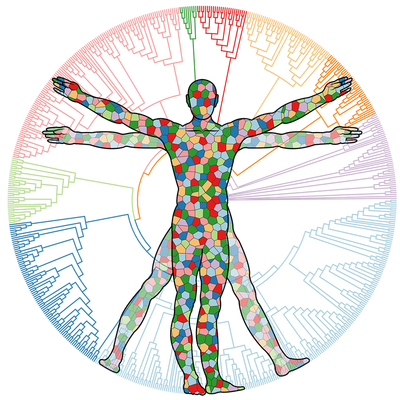Update: In December 2019, Flagship Pioneering unveiled Ring Therapeutics . Founded by Flagship’s innovation foundry, Flagship Labs, Ring is a multi-product platform company focused on discovering and developing Anellovector™ therapeutics to unlock the full potential of gene therapy. Ring is pioneering the first redosable and targetable gene therapy platform by harnessing the biology of the human commensal virome. The company is expanding the applications of gene therapy beyond gene replacement, enabling a much wider array of modalities and mechanisms to treat previously inaccessible diseases. Learn more about the company and their work on the human commensal virome at ringtx.com.

The world of the virome remains underexplored and may offer a rich source of novel viruses to be surveyed, mined, and utilized.
The genomics revolution is illuminating the human body in high definition. Researchers have found the molecular roots of many diseases by studying the human genome itself, as well as the transcriptome, proteome, and epigenetic factors. Modern sequencing now also allows scientists to map the diverse world of microbes, most notably the human microbiome, which interact with us and affect our health in varied ways.
Genomic scientists have more data to explore than ever before, but it can be easy to overlook what might be important. We set aside sequences we don’t obviously recognize or understand to study those we do: the known genes, transcripts, and microorganisms. However, most genetic material that is sequenced remains uncharacterized and poorly understood: the so-called genomic dark matter. Much of this dark matter comes from unclassified and unculturable microorganisms, some of which are viruses we find repeatedly in healthy human samples. The world of the virome thus remains underexplored and may offer a rich source of novel viruses to be surveyed, mined, and utilized.
By virtue of their intimate genetic interactions with humans, viruses have played a role in shaping us as a distinct species.
A vast unexplored galaxy of viruses
Viruses are molecules at the edge of life: organized bits of genetic material encased in a protein shell, reliant on other living cells to multiply. The virus world makes up the most abundant component of the biosphere, and scientists have illuminated its complexities through advances in sequencing technology and computational genomics, and through sheer brute force. As when Leeuwenhoek peered at microorganisms through the first microscopes, wherever we direct our virus-seeking methods, we apprehend a vast galaxy of viruses, previously unseen. Recent efforts have revealed viruses in everything from Antarctic ice to arthropods to healthy human blood—long thought to be sterile—and all of these investigations remind us that life contains multitudes.
Much of virus research has gravitated toward uncovering sources of disease. But the same tools used to discover pathogens have also unearthed the makeup of the commensal human virome: the milieu of benign viruses that is part of what makes us human. In fact, over millions of years of co-evolution with viruses, we humans have hijacked viral components for our own benefit. By virtue of their intimate genetic interactions with humans, viruses have played a role in shaping us as a distinct species. Relics of ancient retroviral infections litter the human genome today (representing ~10% of the genome). Humans have co-opted spare parts of these junk viruses for regulating essential biological functions. Syncytin, for instance, a human protein that is required for placental formation, arose from a viral envelope protein. This and similar genetic elements are highly divergent from those of other mammals and primates.
In addition to these widespread intragenomic viral elements, there exists a panoply of recently discovered eukaryotic commensal viruses that live among virtually all humans. These viruses have the ability to persist both inside cells and in circulation, seemingly unfettered, thereby blurring the line between what is human and nonhuman. Flagship Pioneering is actively exploring this expansive, unexplored, and under-appreciated component of human biology, the commensal virome.
What if we all harbor material that can be safely harnessed as therapies?
The ever-present anelloviruses
Some constituents of our virome, such as anelloviruses, are particularly remarkable. (Derived from anellus, Latin for “little ring,” their name pays homage to their small, circular DNA genomes.) Since their discovery 20 years ago, many new and diverse isolates of the anellovirus family, which includes the torque teno viruses, have been routinely identified in human sequencing studies, and the anelloviruses have become recognized as a ubiquitous component of the human virome. In fact, they may reside permanently in healthy blood. Anelloviruses are also detected in many other tissues of most healthy people across the world and remain with us throughout our lives. We need to re-envision our connection to these viruses. Our overarching hypothesis is that the ever-present episomal genomes of anelloviruses can be considered an extrachromosomal component of our own genetic makeup.
What if we can harness the commensal virome to deliver DNA medicines?
New insights into virology may in turn lead to repurposed viral-based tools to prevent and treat disease. Tremendous progress has been made in the field of gene therapy over the last 10 years for the treatment of a variety of inherited diseases. Some of the most well-studied nonpathogenic viruses, such as adeno-associated viruses (AAVs), are leading vectors for gene therapy, but the promise of DNA medicines using AAVs has faced several challenges. For one, many patients cannot be treated with AAV-based therapies because they already produce neutralizing antibodies to different AAV serotypes. Redosing is not a possibility with AAV and in organs where dividing cells are targeted, as the treatment effects are eventually diluted. At higher doses, AAVs can elicit a robust T cell response that wipes out the treatment effects. AAVs also cannot target many important cell types, limiting their potential for many categories of disease.
As we learn more about the commensal virome and its anelloviruses, we become able to explore how these commensal viruses can also be engineered to improve human health. What if we all harbor material that can be safely harnessed as therapies?
Flagship Pioneering is exploring the virome to solve these longstanding challenges on the hypothesis that naturally occurring commensal viruses could be used to pioneer a completely novel conduit of DNA therapy. We are just scratching the surface of a vast and hitherto unexplored sphere of human biology, which constitutes a parallel genome. With the right tools and a pioneering mindset, we can harness even the most deeply hidden elements of this underappreciated system to create new medicines.
If you see an error in this story, contact us.
Related Companies
- Ring Therapeutics Founded: 2017







